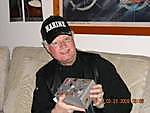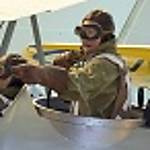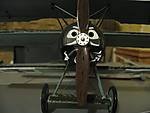Greetings all from time to time we use terms that we hope others understand here is a thread dedicated to helping you the modeler understand terms we use here.
For instance (because it is popular now.) Striped fuselage.
There are markings we might try to duplicate where the word stripe really does not apply.
Stripes usually lay for to aft horizontally like on Terri's recent Pfalz D.IIIa. This means the colours travel from nose to tail.
Modified Stripes are like stripes but are broken by the undersurface of the fuselage not being overpainted. They are only on the upper surfaces.
Bands are strands of colours that travel in one ring veritcally around the fuselage. Now these can have multiple repitions. Maj. Barker's Camel B6313 for instance.
Modified Bands are like Bands but are broken by the undersurface of the fuselage not being overpainted. They are only on the upper surfaces.
Ribbons are sections of colour that wrap entirely around a fuselage traveling from nose to tail. The Jasta 4 unit marking on their Albatros D.V & Va types is a good example Also the Jasta 73 unit marking on their Alb. D.Va and Fokker D.VII aircraft.
Modified Ribbons are like Ribbons but are broken by the undersurface of the fuselage not being overpainted. They are only on the upper surfaces.
Early Aviation
Discuss World War I and the early years of aviation thru 1934.
Discuss World War I and the early years of aviation thru 1934.
Hosted by Jim Starkweather
Just a bit of terminology

JackFlash

Joined: January 25, 2004
KitMaker: 11,669 posts
AeroScale: 11,011 posts

Posted: Tuesday, September 08, 2009 - 03:27 PM UTC

JackFlash

Joined: January 25, 2004
KitMaker: 11,669 posts
AeroScale: 11,011 posts

Posted: Wednesday, September 09, 2009 - 12:45 PM UTC
Cabane struts are the support struts that run from the fuselage to the upper wings on biplane, triplane configurations.
Interplane struts the support struts that run fromwing to wing on biplane, triplane comfigurations.
Interplane struts the support struts that run fromwing to wing on biplane, triplane comfigurations.

JackFlash

Joined: January 25, 2004
KitMaker: 11,669 posts
AeroScale: 11,011 posts

Posted: Thursday, September 10, 2009 - 03:21 PM UTC
Stitching is the thread that brings togther two fabric panels in a permanent seam.
Lacing is the threading of a cord through eyelets to form a panel access that can be opened for maintenance purposes.
Lacing is the threading of a cord through eyelets to form a panel access that can be opened for maintenance purposes.

jaypee

Joined: February 07, 2008
KitMaker: 1,699 posts
AeroScale: 1,384 posts

Posted: Thursday, September 10, 2009 - 11:07 PM UTC
Quoted Text
Greetings all from time to time we use terms that we hope others understand here is a thread dedicated to helping you the modeler understand terms we use here.
For instance (because it is popular now.) Striped fuselage.
There are markings we might try to duplicate where the word stripe really does not apply.
Stripes usually lay for to aft horizontally like on Terri's recent Pfalz D.IIIa. This means the colours travel from nose to tail.
Modified Stripes are like stripes but are broken by the undersurface of the fuselage not being overpainted. They are only on the upper surfaces.
Bands are strands of colours that travel in one ring veritcally around the fuselage. Now these can have multiple repitions. Maj. Barker's Camel B6313 for instance.
Modified Bands are like Bands but are broken by the undersurface of the fuselage not being overpainted. They are only on the upper surfaces.
Ribbons are sections of colour that wrap entirely around a fuselage traveling from nose to tail. The Jasta 4 unit marking on their Albatros D.V & Va types is a good example Also the Jasta 73 unit marking on their Alb. D.Va and Fokker D.VII aircraft.
Modified Ribbons are like Ribbons but are broken by the undersurface of the fuselage not being overpainted. They are only on the upper surfaces.
That's at least 5 more campaigns for Terri

guitarlute101

Joined: December 18, 2006
KitMaker: 1,121 posts
AeroScale: 1,063 posts

Posted: Thursday, September 10, 2009 - 11:52 PM UTC
How about a "Modified Banded Striped Ribbon Campaign"?
 Just kidding, Terri.
Just kidding, Terri.This is a very helpful and useful thread Stephen. Keep em coming.
Mark

Tango-India-Mike

Joined: August 31, 2009
KitMaker: 88 posts
AeroScale: 79 posts

Posted: Friday, September 11, 2009 - 12:21 AM UTC
"gentlemen...a bird is a feathered flying animal, a plane is a carpentry tool and a chopper is an alternative term for an axe. Do not confuse these things with aeroplanes, helicopters or any other type of aircraft or you'll appear childish and silly...and we do our best not to recruit childish or silly people".
R.A.A.F. instructor, 1975.
R.A.A.F. instructor, 1975.


JackFlash

Joined: January 25, 2004
KitMaker: 11,669 posts
AeroScale: 11,011 posts

Posted: Sunday, September 13, 2009 - 05:39 PM UTC
Longerons are the horizontal corner supports (four total) for the fuselage Skeletal structure and run in most cases from nose to tail king post. Two upper and two lower.
Stringers are horizontal forming strips that run between and parallel to the longerons. These are in place to help define the round or oval crossesction to the fuselage.
Fuselage formers are the vertical stations that define the basic shape and travel of the fuselage profile. Longerons and stringers are fitted to the out side perimeter of these formers usually in notches that match from former to former.
Stringers are horizontal forming strips that run between and parallel to the longerons. These are in place to help define the round or oval crossesction to the fuselage.
Fuselage formers are the vertical stations that define the basic shape and travel of the fuselage profile. Longerons and stringers are fitted to the out side perimeter of these formers usually in notches that match from former to former.
thegirl

Joined: January 19, 2008
KitMaker: 6,743 posts
AeroScale: 6,151 posts

Posted: Monday, September 14, 2009 - 01:15 AM UTC
Very funny guy's , very funny !
Thanks for sharing this tib bit stuff with us Stephen . Who knows maybe I will get my terms facing the right direction
Thanks for sharing this tib bit stuff with us Stephen . Who knows maybe I will get my terms facing the right direction


JackFlash

Joined: January 25, 2004
KitMaker: 11,669 posts
AeroScale: 11,011 posts

Posted: Saturday, October 31, 2009 - 05:01 PM UTC
Oil Pulsator is an instrument that has a tubular glass at it apex and shows by its periodic pluse of oil that the pump is functioning. It is attached within the cockpit for the pilot's visual inspection. It has by its nature a receiving line from the oil pump and a sending line to the engine.
An anemometer is a device for measuring the wind speed. Germany used Morrell types attached to interplane struts to measure air speed. These were typified by a spinning ring of 4 cups at the apex of the gauge housing.
An anemometer is a device for measuring the wind speed. Germany used Morrell types attached to interplane struts to measure air speed. These were typified by a spinning ring of 4 cups at the apex of the gauge housing.

JackFlash

Joined: January 25, 2004
KitMaker: 11,669 posts
AeroScale: 11,011 posts

Posted: Monday, October 18, 2010 - 04:15 PM UTC
Nachrichtenblatt der Lufstreitkräfte
The biweekly reports of the German Army Air Service from 1917 through half of 1918.
It contained general information and victories and losses from the previouas 2 week period. A good research tool but the early form of the report was in old German Gothic print in 1918 the print became more modernized. Tough read but a great tool. Most of its information has been reprinted in various forms by German aviation authors. It takes up 2 three-ring binder. One 14 inch legal size the othe 11 inch.
Marine Nachrichtenblatt der Lufstreitkräfte
The biweekly reports of the German Naval Air Service of 1918.
The biweekly reports of the German Army Air Service from 1917 through half of 1918.
It contained general information and victories and losses from the previouas 2 week period. A good research tool but the early form of the report was in old German Gothic print in 1918 the print became more modernized. Tough read but a great tool. Most of its information has been reprinted in various forms by German aviation authors. It takes up 2 three-ring binder. One 14 inch legal size the othe 11 inch.
Marine Nachrichtenblatt der Lufstreitkräfte
The biweekly reports of the German Naval Air Service of 1918.

JackFlash

Joined: January 25, 2004
KitMaker: 11,669 posts
AeroScale: 11,011 posts

Posted: Tuesday, October 19, 2010 - 09:18 PM UTC
In the case where the national markings on the wings have a background not just a border the backgrounds are called "Fields".

JackFlash

Joined: January 25, 2004
KitMaker: 11,669 posts
AeroScale: 11,011 posts

Posted: Saturday, October 15, 2011 - 03:58 PM UTC
Usually with WWI Vintage aircraft there are 3 magnetos. 1 @ The starting magneto in the cockpit and has a key or small handle to turn. It sends the electrical current to the engine magnetos. 2 @ the engine magnetos are on the rear of a rotary or inline motor and send spark to the leads and sparkplugs.

Mgunns

Joined: December 12, 2008
KitMaker: 1,423 posts
AeroScale: 1,319 posts

Posted: Sunday, January 01, 2012 - 11:39 AM UTC
 Thanks Stephen for putting these out there. I had some idea of what some of them meant, but no totally sure on others. This clarified it for me.
Thanks Stephen for putting these out there. I had some idea of what some of them meant, but no totally sure on others. This clarified it for me.Thanks
Mark

JackFlash

Joined: January 25, 2004
KitMaker: 11,669 posts
AeroScale: 11,011 posts

Posted: Friday, April 06, 2012 - 02:42 PM UTC
Unstickying this to make room. Whew! Lots of activity in the KotS II GB.

JackFlash

Joined: January 25, 2004
KitMaker: 11,669 posts
AeroScale: 11,011 posts

Posted: Friday, February 21, 2014 - 03:29 PM UTC

"This year will mark the 100th anniversary of the start of the First World War. (Mental Floss has been commemorating it in a series of articles on the events leading up to the war). The Oxford English Dictionary is honoring the centenary with an appeal to the public for help in finding the earliest documented uses of words that first came into English during World War I. The current citations for these words are from magazines and newspapers, but there may be earlier examples in personal letters, soldiers' diaries, or government records. Can you find earlier uses? Submit your evidence and help the OED capture the history of our language.
1. Camouflage
Camouflage had been used in French to mean "disguise" since the 19th century. The earliest evidence of its use in English, in reference to hiding weapons from the enemy, comes from 1916.
2. Shell shock
A 1915 study by psychologist Charles Samuel Myers titled, "A contribution to the study of shell shock" is the first documentation for the use of this term in English. "But some accounts suggest that Myers did not invent the term; that it was already in use at the front and Myers merely popularized it (and regretted it: in a later book he described shell shock as a ‘singularly ill-chosen term’)."
3. Jusqu'auboutiste
Jusqu'au bout, "until the end" in French, was the basis for the formation of this noun referring to someone willing to stick it out until the bitter end, to carry a conflict to extremes without worrying about the consequences. The earliest example is from a 1917 issue of Punch, but the use of "jusqu'au bout" in English to describe the attitude goes back at least as early as 1915 so the noun may have been formed earlier.
4. Demob
Short for demobilization. The first quotations for both the noun and verb form come from 1919.
5. Streetcar (meaning "a shell")
The earliest citation for this slang term is from 1920, but the novelist Raymond Chandler claimed in a 1950 letter that this had been one of "the most commonly used words of soldier-slang" when he served in WWI. There may be more evidence out there for this one.
6. Conchie
Short (and usually derisive) for "conscientious objector." The earliest quote comes from a 1917 Daily Mail article. Britain began military conscription in 1916.
7. Trench foot/mouth
The trench warfare of WWI was brutal, and the environment of the trenches where soldiers spent so much time led to painful conditions they called trench foot, and trench mouth. The earliest printed evidence for these terms comes from 1915 and 1917 respectively.
8. Tank (as a verb)
The military tank was first used in 1916 and the word has been used as a noun ever since, but we only have evidence of tank used as a verb in the sense of "attack with a tank" or "travel by tank" since 1930. The OED editors say that while "there is plenty of earlier evidence for the verb tank relating to the noun meaning ‘large receptacle’, we find it surprising that there are no earlier uses of the verb relating to the military vehicle. Is there evidence we haven’t found yet?"
9. Eyetie
Also spelled as "iti" or "eyety," this was a slang term for an Italian. The earliest evidence for this form is a 1919 quote claiming that "our army in Italy always spoke of the Italians as the 'Itis' (pronounced 'Eye-ties')."
10. Zeppelins in a cloud
This phrase was used to mean "sausage and mashed potatoes" according to a 1925 dictionary of Soldier & Sailor Words. But so far no pre-1925 documentation has been found. (Edit: Usually found in local WWI BEF unit printed mess menus.)
11. Sam Browne (meaning "an officer")
Army officers used to wear leather harness' called Sam Browne belts in the 19th century, and that gave rise to the use of Sam Browne as a slang term for officer during WWI, though the first evidence for the use is from 1919." (Edit: In WWI the Sam Browne belts worn by officers were a simple waist utility belt with a shoulder strap to draw support from the opposite shoulder a saber was to be worn on.)
here.

CaptnTommy

Joined: October 26, 2009
KitMaker: 424 posts
AeroScale: 389 posts

Posted: Tuesday, February 25, 2014 - 04:45 AM UTC
Quoted Text
"gentlemen...a bird is a feathered flying animal, a plane is a carpentry tool and a chopper is an alternative term for an axe. Do not confuse these things with aeroplanes, helicopters or any other type of aircraft or you'll appear childish and silly...and we do our best not to recruit childish or silly people".
R.A.A.F. instructor, 1975.
oBVIOUSLY THIS INSTRUCTOR NEVER APPRICIATED Monty Python.
Posted: Tuesday, February 25, 2014 - 08:31 AM UTC
Add a couple more
Rib stitching; sews the wing top covering to the bottom covering with the thread passing either side of the wing ribs. Each stitch is knotted seperately. A needle longer than the wing thickness is needed (Cleopatric needle)
Rib tape, a narrow piece of fabric doped over the rib stitches to seal them
Dope, a cellulose based preparation used to seal and shrink the cotton covering.
Ribs; the fore and aft components of the wing that maintain the aerofoil shape
Spars run along the wing forming the major strength components in the wing and holding the ribs in place
Rib stitching; sews the wing top covering to the bottom covering with the thread passing either side of the wing ribs. Each stitch is knotted seperately. A needle longer than the wing thickness is needed (Cleopatric needle)
Rib tape, a narrow piece of fabric doped over the rib stitches to seal them
Dope, a cellulose based preparation used to seal and shrink the cotton covering.
Ribs; the fore and aft components of the wing that maintain the aerofoil shape
Spars run along the wing forming the major strength components in the wing and holding the ribs in place
 |











